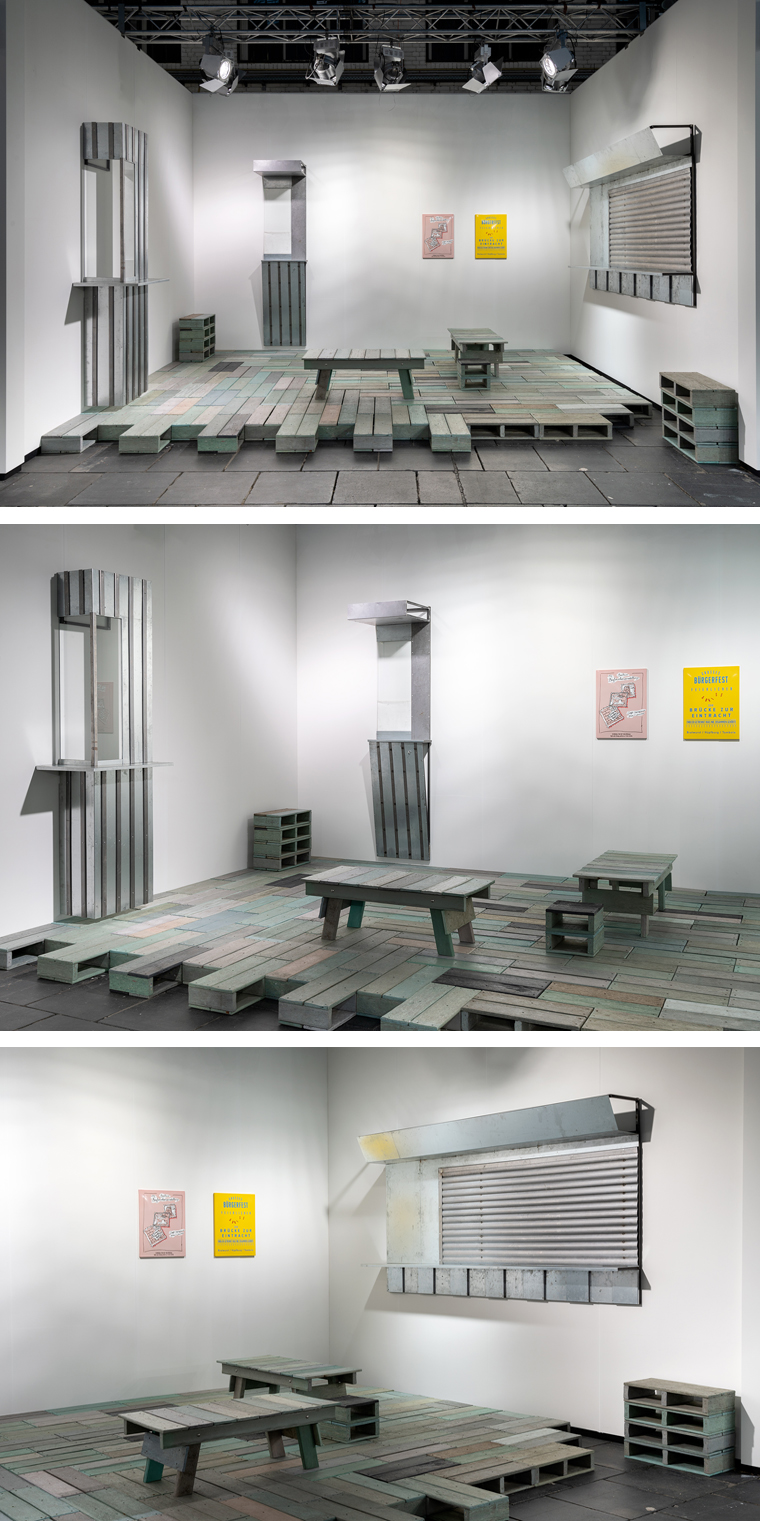
Art Berlin 2018
With Wilhelm Klotzek and Dan Peterman
September 27 to 30, 2018
Booth 1.A.1.
For art berlin 2018, Klosterfelde Edition presented for the first time works by Wilhelm Klotzek, in dialogue with an installation by Dan Peterman.
If the latter represents an ongoing, intensive engagement with ecological and (socio-) economic issues since the 1980s—manifested in the creation of a long- term, alternative project on Chicago’s Southside simply referred to for a long time as The Building, as well as material-based, conceptual installations, and other works—Klotzek is best known for his quirky sculptures, videos, and performances, interspersed with sound poetry and word jugglings, in which he takes up everyday cultural or even political-historical phenomena.
Both pursue a sustained sculptural practice whose quality is strongly characterized by a precise application of the materials employed. Peterman’s style-defining, reprocessed post-consumer plastic, i.e. plastic that has been re-melted after consumer use and molded into massive boards or beams, which the artist obtained from a recycling company experimenting with this material, forms the basis of the Accessories to an Event work series, which began in 1996. This series was also part of his contribution to the 2nd Berlin Biennale in 2001 (61st Street Bottlecap Pasta), while another version, Accessory to an Event (plaza) from 1998, was recently reinstalled in front of the MCA in Chicago. The material’s various color shades result from the random composition of recycled plastics; the weight of the modules always references the annual consumption of plastic by consumers in a particular context. The small pallets and benches offer infinitely possible variations: spread out as a durable floor covering or piled high as a shelf or minimal wall sculpture, they are adapted to any spatial situation and functional use. But it is the awareness of the energy stored in them, the endless transformative potential inherent to the plastic material, and its problematic sustainability that account for the timeless quality and special presence of these works.
Wilhelm Klotzek’s wall reliefs Imbiss (1-4), by comparison, seem literally wrested from their functionality: fragments of replicas of Schnellbüfetts (fast-food spots) created from sheet metal, inspired by actual examples from the Naschmarkt in Vienna or Alexanderplatz in Berlin, push to the extreme the minimalism of these small architectural forms that are already stripped down to the bare essentials—a closed shutter, the intimation of a frosted glass window as a privacy screen that Helga Maria Klosterfelde Edition graciously conceals what is fried and cooked here, or the small protuberance for hungry patrons to lean against, are enough of a suggestion for identifying the objects that at first glance seem like abstract mural reliefs. Similar façade fragments are familiar from major construction sites, when a module in the form of a 1:1 model is installed in order to test out the original materials under actual weather conditions. Klotzek’s reliefs, however, neither serve such a functional visualization for future use nor are they the actual remnants of existing architectures—instead one might call them sculptural and slightly abstracted memory markers.
Feierlicher Abriss der Brücke zur Eintracht, Regionale Schattierungen der Motte, and 12. Berliner Briefmarkenausstellung (Festive Demolition of the Unity Bridge, Regional Shades of the Moth and the 12th Berlin Stamp Exhibition): the three enamel signs designed by Klotzek evidently serve the purpose of communicating information in public space—directed toward highly specialized experts or generally interested citizens. Classifying them temporally is not really possible, even if the typography or a venue like the Kulturhaus Peter Edel, which has been vacant for ten years, may intimate this. As informational panels of natural history (with geopoetical surplus value) or announcements of permanent potential events, they, like the snack bars, are indices of a subjective present.
By contrast, Peterman’s post-consumer plastic incorporates fragments of our collective past as consumers into a material presence that can exist as a performative infrastructure as well as an autonomous work of art. Both artistic positions open up fragmentary glimpses into food chains, energy cycles, and the waste material associated with them—the body of the ultimate consumer leaning on a snack bar counter or standing like cargo on a platform of pallets.
Text by Bettina Klein
Translation by Erik Smith
